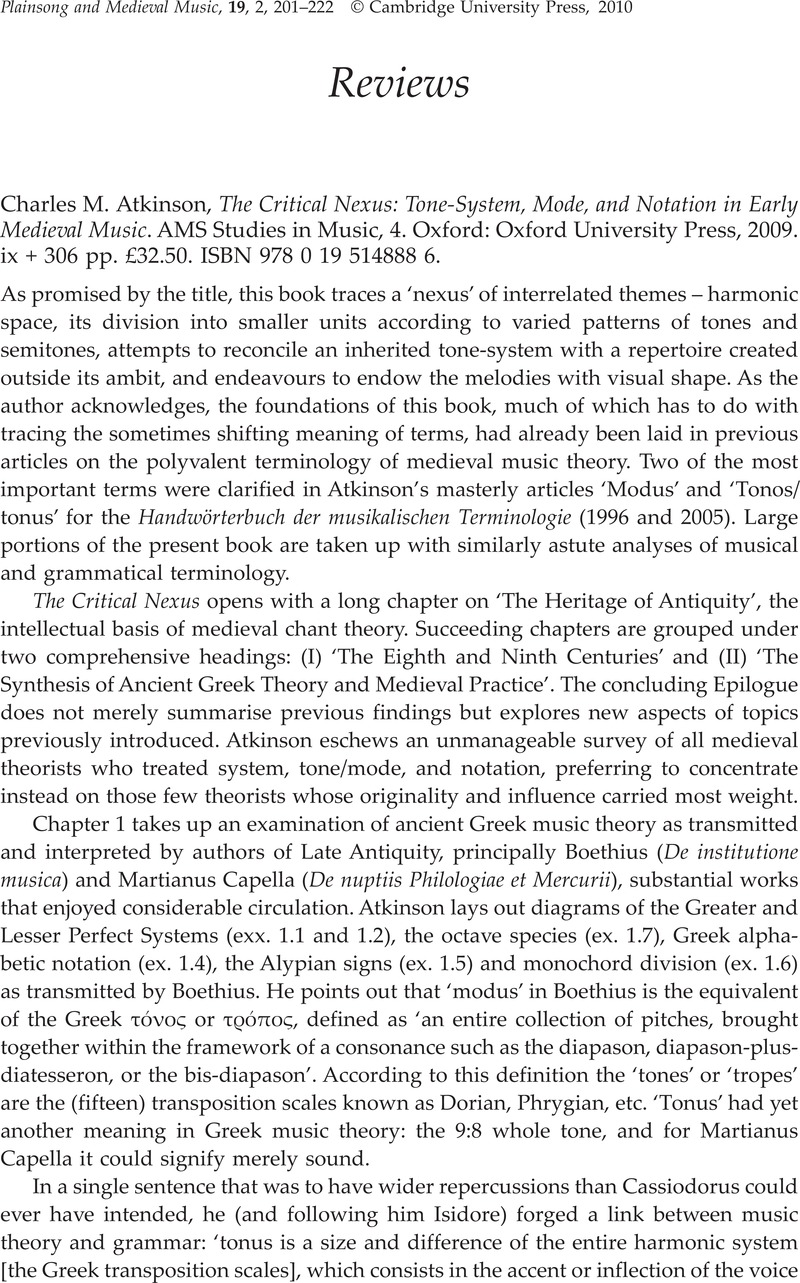No CrossRef data available.
Published online by Cambridge University Press: 17 September 2010

1 ‘Tonus est totius constitutionis armonicae differentia et quantitas, quae in vocis accentu sive tenore consistit’, as quoted in The Critical Nexus, 39.
2 For a large selection of texts in translation see Copeland, Rita and Sluiter, Ineke, eds, Medieval Grammar and Rhetoric: Language Arts and Literary Theory, AD 300–1475 (Oxford, 2009)Google Scholar .
3 See ars maior 1.5: ‘plane sive accentum dicas sive tonum sive tenorem idem est [aut hoc est]’.
4 Apart from references to papadikai, the much later Byzantine singers' manuals, there is no substantial discussion in The Critical Nexus of what can be known of Byzantine theory.
5 For a colour reproduction of fol. 71v from this manuscript with two palaeofrankish insertions over intonation formulae see Page, Christopher, The Christian West and its Singers: The First Thousand Years (New Haven, 2010), 360 (pl. 69Google Scholar ).
6 A parallel phenomenon in the Byzantine papadikai, the manuscript tradition of which begins only in fourteenth century, may be related, but a link cannot be established with any certainty.
7 Beatus servus comes up several times in later chapters of The Critical Nexus.
8 The syllables of one of his examples, Ecce vere Israhelita, are arrayed on parallel horizontal lines that recall the Enchiriadis treatises (here ex. 4.1).
9 As it turns out, Gerbert's edition is a better guide to the medieval arrangement of the parts of the treatise.
10 Atkinson substitutes ‘praemissus expositor’ and ‘expositor’ for the first two.
11 Gerbert, Martin, ed., Scriptores de musica sacra potissimum, 3 vols. (St Blaise, 1784), 1: 313–314Google Scholar .
12 Gerbert, , Scriptores 1: 330–338Google Scholar .
13 ‘Questions of Attribution and Chronology in Three Medieval Texts on Species Theory’, Music Theory Spectrum 22 (2000), 225–35.
14 It did not hurt, of course, that the ‘Guidonian’ hand was (falsely) attributed to him.
15 As Atkinson observes, a supposedly inspired repertory traced back to Gregory the Great could hardly be criticised directly.
16 See also the recent publication of Prosdocimo de' Beldemandi's Plana musica and Musica speculativa, ed. Jan Herlinger, Studies in the History of Music Theory and Literature 4 (Urbana-Chicago, 2008).
17 I did not notice a reference to the fact that the original texts of medieval music treatises are conveniently available through the Thesaurus musicarum latinarum, (available as a CD-ROM from the Center for the History of Music Theory and Literature at Indiana University or online at www.music.indiana.edu/tml).